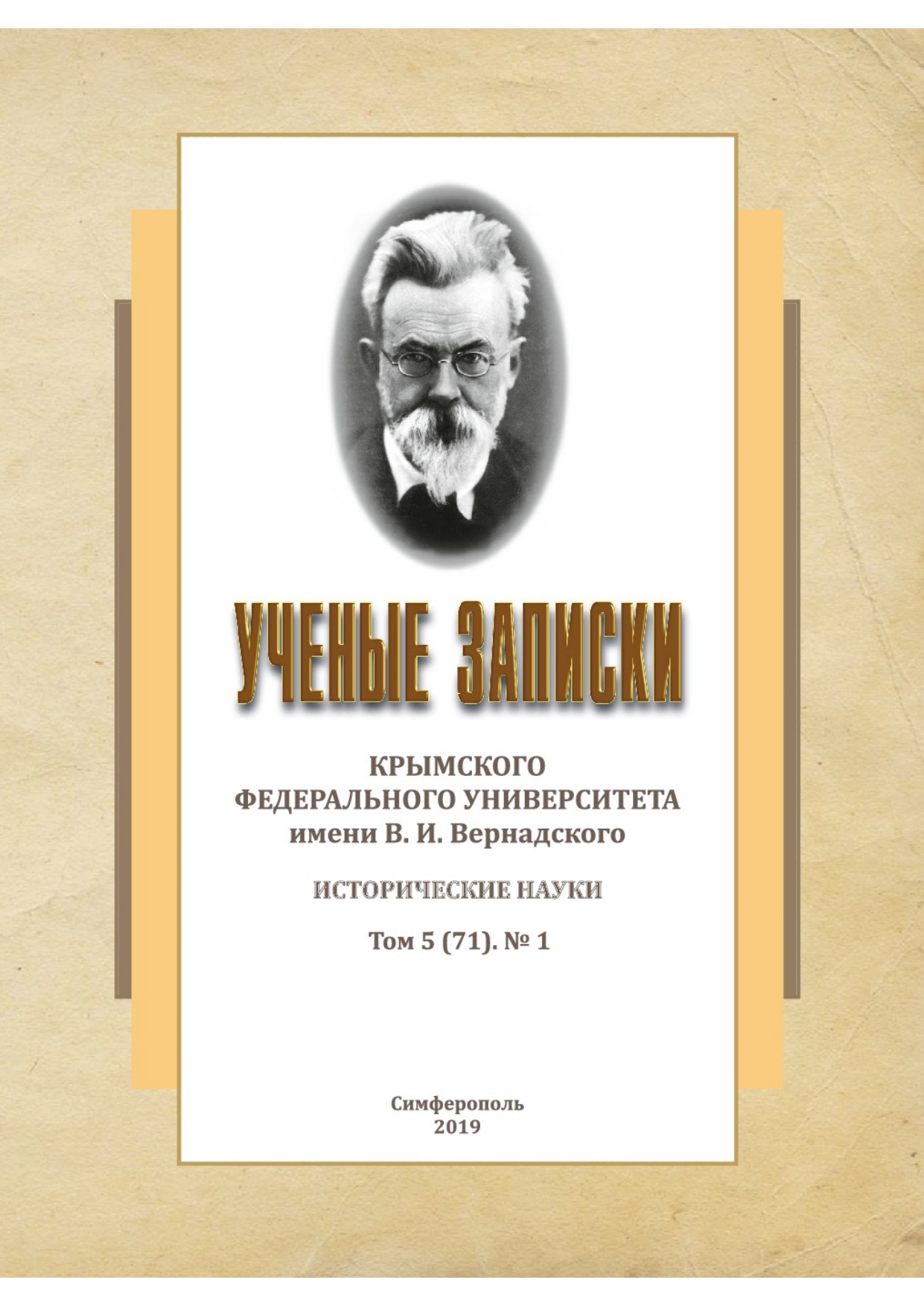This article is devoted to the study of the role and place of the collaborationist auxiliary police, which was an important part of the Nazi security forces during the occupation of Soviet territories. The reasons for the appearance and genesis of such police formations are shown on the example of the Belarusian SSR. Their typology is considered, with the help of which it was possible to establish that the main types of police in the territory of this Soviet republic were the «service of order», «self-defense» and Auxiliary Police of order, the reasons for the creation of which directly depended from the increase in the level of partisan danger in the occupied territories. As a result of the conducted research, it was found that the auxiliary police were the most massive collaborationist formations in the occupied Soviet territories, and their role in Nazi repressive policies (for example, participation in the Holocaust) is quite significant. Nevertheless, the level of combat capability of the police remained low for a number of reasons and only decreased with the course of the occupation, which forced the Nazi administration to look for other forms of military collaboration. One of these reasons was the interethnic relations on the territory of the Belarusian SSR, which allows us to call the auxiliary police an essential factor in the dynamics, for example, of Belarusian-Polish and Belarusian-Russian relations.
Byelorussian SSR, Nazi occupation, collaboration, auxiliary police, Holocaust, interethnic relations
1. Akula K. Zmagarnyya darogі: Apoves'c'. – Minsk: Mastackaya lіteratura, 1994. – 572 s.
2. Belarus na varce. – 1943. – № 1.
3. Belarus na varce. – 1944. – № 4.
4. Belarus na varce. – 1944. – № 6.
5. «Brigada Rodionova, poluchivshaya naimenovanie 1-y antifashistskoy partizanskoy brigady…» // Voenno-istoricheskiy zhurnal. – 2003. – № 12. – S. 20–23.
6. Bul'ba-Borovec' T. Armiya bez derzhavi. Slava i tragediya povstans'kogo ruhu. – Vinnipeg: Volin', 1981. – 328 s.
7. Vіr V. Maer Belaruskay Kraevay Abarony Ўsevalad Rodz'ka // Belaruskі Golas. – 1991. – № 365. – Kastrychnіk.
8. Gelagaeў A. Belaruskiya nacyyanal'nyya vayskovyya farmacyi ў chase Drugoe sus'vetnae vayny. – Mensk: Golas Krayu, 2002. – 72 s.
9. Gosudarstvennyy arhiv Respubliki Krym. – F. P-151. – Op. 1. – D. 391.
10. Gryboўski Yu. Pol'ska-belaruski kanflikt u General'nay akruze «Belarus'» (1941–1944 gg.) // Białoruskie Zeszyty Historyczne. – 2006. – № 25. – S. 116–167.
11. Din M. Posobniki Holokosta. Prestupleniya mestnoy policii Belorussii i Ukrainy, 1941–1944. – SPb.: Akademicheskiy proekt, 2008. – 268 s.
12. Drobyazko S. I. Vostochnye dobrovol'cy v vermahte, policii i SS. – M.: AST, 2000. – 48 s.
13. Ioffe E. G. K voprosu o roli kollaboracionistov v katastrofe na belorusskoy zemle // Evrei Belarusi. Istoriya i kul'tura. – Minsk, 1998. – Vyp. 3–4. – S. 164–178.
14. Kushal' F. Sproby stvaren'nya Belaruskaga voyska. – Minsk: Belaruski Gistarychny Aglyad, 1999. – 164 s.
15. K’yary B. Shtodzennas'c' za lіnіyay frontu. Akupacyya, kalyaboracyya і supracіў u Belarusі (1941–1944 gg.). – Minsk: Belaruski Gistarychny Aglyad, 2005. – 390 s.
16. Nacional'nyy arhiv Respubliki Belarus'. – F. 383. – Op. 1. – D. 11.
17. Okorokov A. V. Antisovetskie voinskie formirovaniya v gody Vtoroy mirovoy voyny. – M.: Voennyy universitet, 2000. – 174 s.
18. Pankratov P. A. «Mrak i tuman» // Voenno-istoricheskiy zhurnal. – 1998. – № 3. – S. 14–20.
19. Popov A. Yu. NKVD i partizanskoe dvizhenie. – M.: Olma-Press, 2003. – 383 s.
20. Ranіca. – 1943. – 19 veras'nya.
21. Roman'ko O. V. Iz kollaboracionistov v maki: k voprosu ob uchastii vostochnyh dobrovol'cev 30-y grenaderskoy divizii voysk SS v ryadah francuzskih partizan // Rossiyskaya emigraciya v bor'be s fashizmom.
22. Rossiyskiy gosudarstvennyy arhiv social'no-politicheskoy istorii (RGASPI). – F. 69. – Op. 1. – D. 1141.
23. RGASPI. – F. 625. – Op. 1. – D. 44.
24. Chuev S. G. Proklyatye soldaty. – M.: Eksmo; Yauza. – 576 s.
25. Archiwum Akt Nowych (AAN). – Mikrofilmy aleksandrijskie. – T-78. – Roll 413.
26. AAN. – Mikrofilmy aleksandrijskie. – T-175. – Roll 225.
27. AAN. – Mikrofilmy aleksandrijskie. – T-175. – Roll 226.
28. AAN. – Mikrofilmy aleksandrijskie. – T-175. – Roll 233.
29. AAN. – Mikrofilmy aleksandrijskie. – T-175. – Roll 235.
30. Bundesarchiv Freiburg. – RH 22 (Befehlshaber der r'ckwdrtigen Heeresgebiete / Heeresgebiet Mitte). – RH 22/233.
31. Chiari B. Das Schicksal der weiYarussischen Juden im «Generalkommissariat WeiYaruthenien». Eine Anndherung an das Unbegreifliche // Solidaritdt und Hilfe f'r Juden wdhrend der NS-Zeit: In 7 bd. – Berlin, 1999. – Bd. 3. – S. 271–309.
32. Gdański J. Zapomniani żołnierze Hitlera. – Warszawa: Wydawnictwo «De Facto», 2005. – 263 s.
33. Hitlers Weisungen f'r die Kriegsf'hrung 1939–1945. Dokumente des Oberkommandos der Wehrmacht / Hrsg. v. W. Hubatsch. – Frankfurt-am-Main: Bernhard and Graefe Verlag f'r Wehrmacht, 1962. – 330 s.
34. Hoffmann J. Ostlegionen 1941–1943. – Freiburg: Rombach, 1976. – 197 s.
35. Munoz A. J. Hitler's Eastern Legions: In 2 vols. – New York: Axis Europe, 1997. – Vol. 2. – 96 p.
36. Munoz A. J. The Druzhina SS Brigade: A History, 1941–1943. – New York: Axis Europe, 2000. – 98 p.
37. Piotrowski T. Poland‘s Holocaust: Ethnic Strife, Collaboration with Occupying Forces and Genocide in the Second Republic, 1918–1947. – Jefferson, NC: Mac Farland, 1998. – 437 p.
38. Rein L. Local Collaboration in the Executon of the «Final Solution» in Nazi-Occupied Belorussia // Holocaust and Genocide Studies. – 2006. – Vol. 20. – Issue 3. – P. 381–409.
39. Waffen-SS und Ordnungspolizei im Kriegseinsatz 1939–1945. Ein 'berblick anhand der Feldpost'bersicht / Bearb. v. G. Tessin und N. Kannapin. – Osnabr'ck: Biblio Verlag, 2000. – 773 s.





